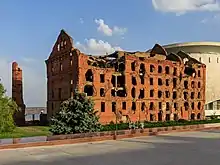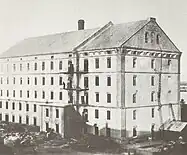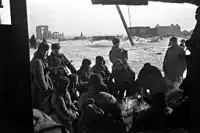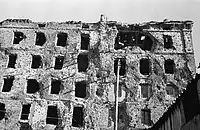Gerhardt's Mill
Gerhardt's Mill (Russian: Мельница Гергардта) is a building of historical significance in the Battle of Stalingrad.[1][2]

Gerhardt's Mill is situated directly across from Pavlov's House in central (modern-day) Volgograd. It is preserved in its bombed-out state and is one of the main landmarks of the Battle of Stalingrad. The mill provided a vital role in the Defense of Stalingrad. The building also had a twin on the floodplain of the Tsaritsa River, which also survived the battle with significant damage. It is one among only 3 buildings that were not restored or repaired from the battle era, along with the command post of the 138th division on Lyudnikov Island and the building of the factory laboratory of the Krasny Oktyabr plant.
History
The history of the mill began in 1899, when the Gerhardt family of entrepreneurs received permission to build a flour-grinding complex in what is now central Volgograd, overlooking the River Volga. The mill was put into operation, and flour sales began on 1 August 1900. The mill operated until a devastating fire in August 1907 destroyed the complex. A new building was built on the same site by May 1908. Despite being called a "mill", it served as a food processing complex, where in addition to the mill, there was also a smokery for fish, butter production facilities, a bakery, and warehouses for finished products.[3] The technical equipment used the most advanced technologies of its time: it had its own generator, which gave independence from the city power grid, its own boiler house (from which the brick smokestack has survived), internal mechanical conveyors (from which there are still broken remnants).[4] In 1911, the company "Gerhardt and heirs" employed 78 workers with 165 working days with a working day of 10.5 hours. Paid salary for the year amounted to 10,342 rubles, the annual turnover of the enterprise is 1,270,000 rubles. After the revolution, the mill was collectivized and nationalized, designated Number 4 among the Stalingrad mills.
Battle of Stalingrad
During the Battle of Stalingrad, Gerhardt's Mill became the final frontier, with the Soviet Red Army deterring the army of German Field Marshal Friedrich Paulus on the approaches to the Volga. Fierce fighting for the mill lasted for several months: it was bombed, and blown up numerous times, but the German Army failed to take it, or pass around it.
The building was semi-surrounded for 58 days, and during those days it sustained numerous hits from air bombs and shells. This damage can still be seen today. Every square meter of the exterior walls was cut by shells, bullets and shrapnel, and the reinforced concrete beams on the roof were broken by direct hits from aircraft bombs. Hundreds of cubic meters of very high-quality brickwork and reinforced concrete were blown out of the building. The sides of the building testify to the different intensities of mortar and artillery fire - minimal on the Volga side, on the other three sides traces of firing from all types of artillery can be seen, as well as loopholes in the window openings made by the defenders of the house. The increased strength and vibration resistance of the reinforced concrete frame, necessary for the operation of industrial equipment of the mill, helped the building to survive and not to be destroyed to the ground.[5]
Gallery
 Original building
Original building Soviet troops during a lull in the fighting. The mill can be seen on the distance on the right.
Soviet troops during a lull in the fighting. The mill can be seen on the distance on the right. The mill after conclusion of the battle of Stalingrad
The mill after conclusion of the battle of Stalingrad
References
- "The Gerhardt Mill: Ruins that Remember the Battle". Retrieved 10 June 2021.
- "Gerhardt's Mill". Retrieved 22 June 2021.
- Документальный фильм «Мельница Гергардта. Взгляд сквозь время», retrieved 2021-09-17
- "Файл:Весь Царицын и Царицинский уезд на 1911 год.pdf", Википедия (in Russian), retrieved 2021-09-17 page 138
- Зельма, Георгий (1942-09-01). "Дом Павлова в Сталинграде". Библиотека изображений "РИА Новости" (in Russian). Retrieved 2021-09-17.